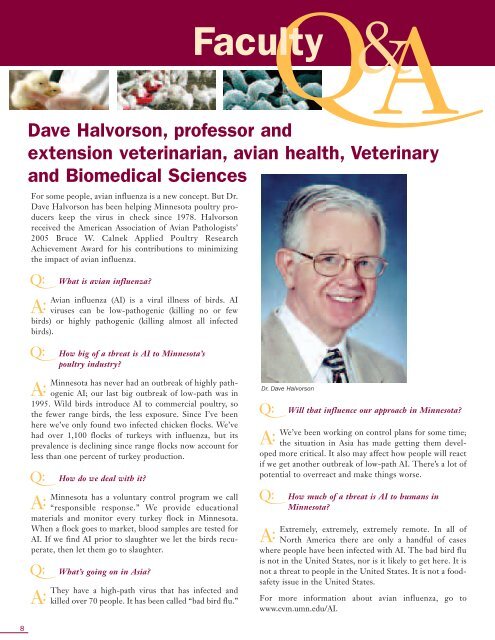Summer 2006 - University of Minnesota College of Veterinary ...
Summer 2006 - University of Minnesota College of Veterinary ...
Summer 2006 - University of Minnesota College of Veterinary ...
- No tags were found...
Create successful ePaper yourself
Turn your PDF publications into a flip-book with our unique Google optimized e-Paper software.
FacultyFaculty8OFacultyDave Halvorson, pr<strong>of</strong>essor andextension veterinarian, avian health, <strong>Veterinary</strong>O:and Biomedical SciencesFor some people, avian influenza is a new concept. But Dr.Dave Halvorson has been helping <strong>Minnesota</strong> poultry producerskeep the virus in check since 1978. Halvorsonreceived the American Association <strong>of</strong> Avian Pathologists’2005 Bruce W. Calnek Applied Poultry ResearchFacultyFacultyAchievement Award for his contributions to minimizingOthe & impact <strong>of</strong> avian influenza.AFacultyO:A:O:A:OO:A:&AWhat is avian influenza?Avian influenza (AI) is a viral illness <strong>of</strong> birds. AIviruses can be low-pathogenic (killing no or fewbirds) or highly pathogenic (killing almost all infectedbirds). &AOO:A:&AHow big <strong>of</strong> a threat is AI to <strong>Minnesota</strong>’spoultry industry?<strong>Minnesota</strong> has never had an outbreak <strong>of</strong> highly pathogenicAI; our last big outbreak <strong>of</strong> low-path was in1995. Wild birds introduce AI to commercial poultry, sothe fewer range birds, the less exposure. Since I’ve beenhere we’ve only found two infected chicken flocks. We’vehad over 1,100 flocks <strong>of</strong> turkeys with influenza, but itsprevalence is declining since range flocks now account forFacultyOO:A:Faculty Faculty&AOO:A:less & than one percent <strong>of</strong> turkey production.AHow do we deal with it?<strong>Minnesota</strong> has a voluntary control program we call“responsible response.” We provide educationalmaterials and monitor every turkey flock in <strong>Minnesota</strong>.When a flock goes to market, blood samples are tested forAI. If we find AI prior to slaughter we let the birds recu-& then let them go to slaughter.Operate, AOO:A:&AWhat’s going on in Asia?They have a high-path virus that has infected andkilled over 70 people. It has been called “bad bird flu.”FacultyOO:A:A:& A&AA:Will that influence our approach in <strong>Minnesota</strong>?Dr. Dave HalvorsonWe’ve been working on control plans for some time;the situation in Asia has made getting them developedmore critical. It also may affect how people will reactFacultyif we get another outbreak <strong>of</strong> low-path AI. There’s a lot <strong>of</strong>FacultyOpotential & to overreact and make things worse.AOO:O: A:A:&AHow much <strong>of</strong> a threat is AI to humans in<strong>Minnesota</strong>?Extremely, extremely, extremely remote. In all <strong>of</strong>North America there are only a handful <strong>of</strong> caseswhere people have been infected with AI. The bad bird fluis not in the United States, nor is it likely to get here. It isnot a threat to people in the United States. It is not a foodsafetyissue in the United States.For more information about avian influenza, go towww.cvm.umn.edu/AI.
















